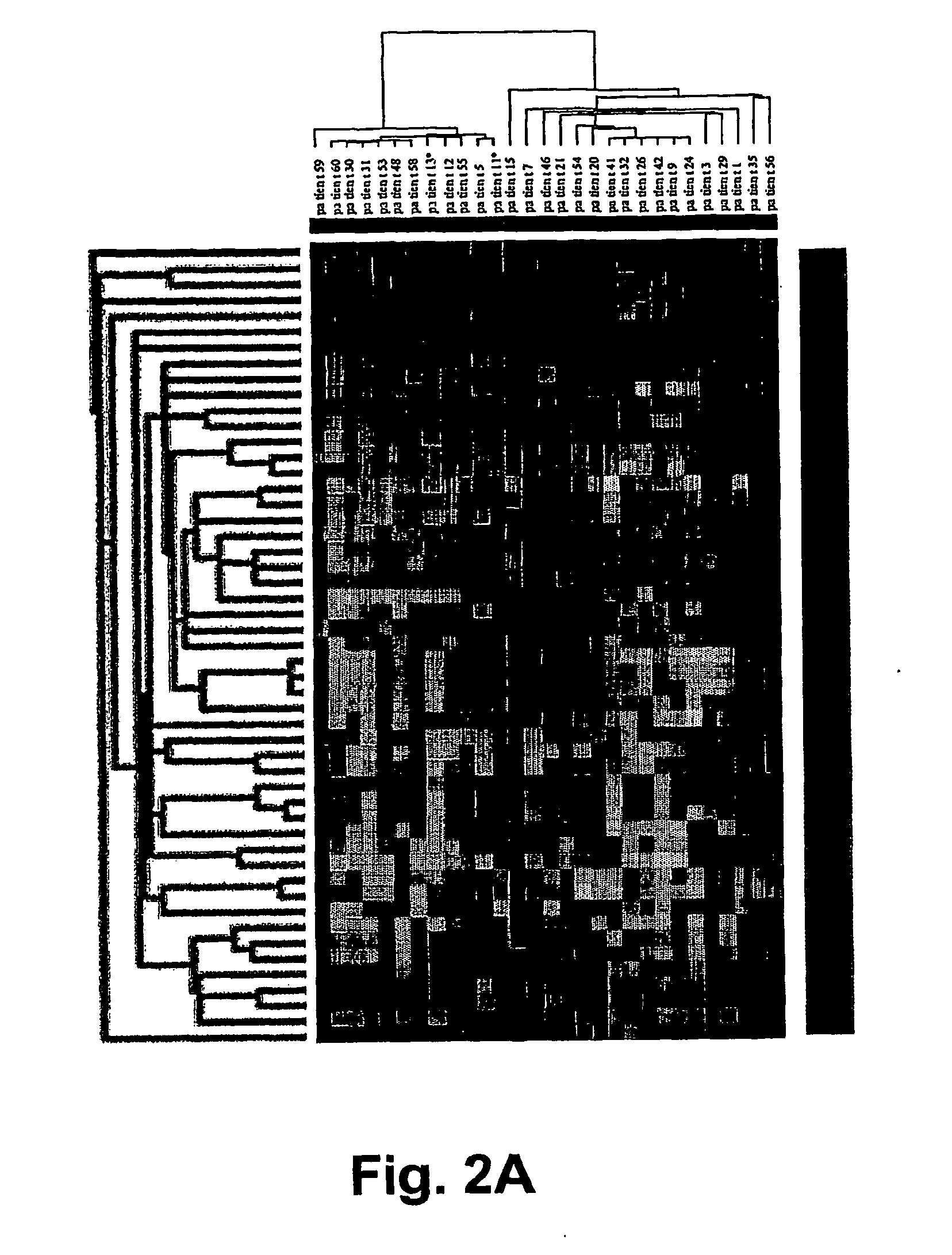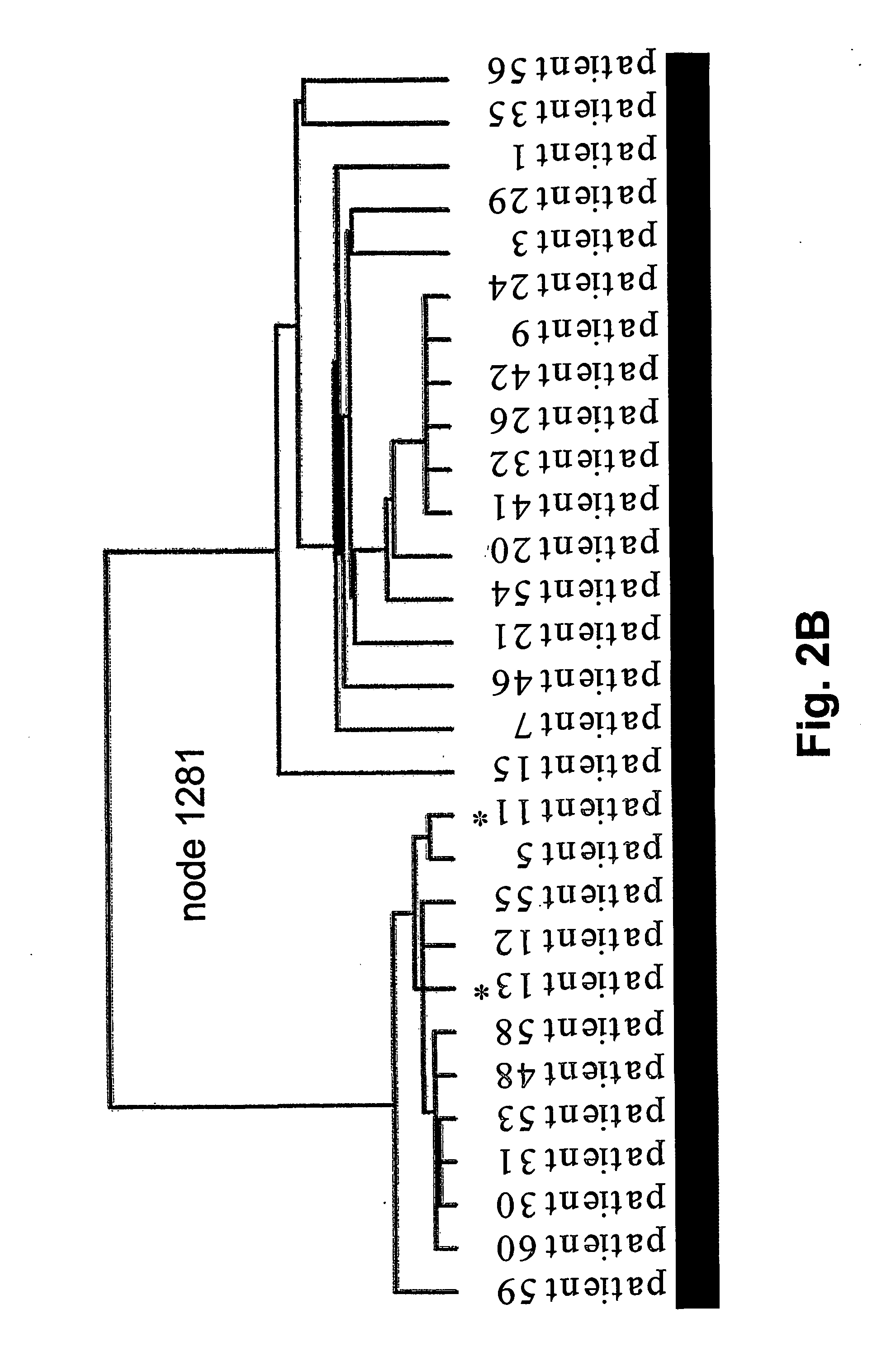Microarray gene expression profiling in clear cell renal cell carcinoma : prognosis and drug target identification
a clear cell renal cell carcinoma and microarray technology, applied in the field of molecular biology and medicine, can solve the problems of limiting long-term survival, no effective tools to identify those patients, and cigarette smoking is a prime risk factor, and achieve the effect of facilitating fluorescence detection
- Summary
- Abstract
- Description
- Claims
- Application Information
AI Technical Summary
Benefits of technology
Problems solved by technology
Method used
Image
Examples
example i
Patients and Tumor Samples
[0142] Tissue samples were from 29 CC-RCC patients at the University Hospital, School of Medicine, Tokushima University (Japan) who underwent radical nephrectomy. Informed consent was obtained for study of surgical specimens and clinico-pathological data. Samples were anonymized prior to the study. A part of each tumor sample was frozen in liquid nitrogen immediately following surgery and stored at −80° C.
[0143] Conventional methods were used for nucleic acid isolation and preparation. Total RNA was isolated using ISOGEN solution (Nippon Gene), and poly(A)+ RNA was isolated from total RNA using the Oligotex mRNA Mini Kit (Qiagen). Remaining tumor tissue was fixed in 10% buffered formalin, sectioned and stained with hematoxylin and eosin. The WHO International Histological Classification of Tumors was used for histological evaluation of the specimens (Sobin, L. H. et al., supra)(TNM classification described above) with standard follow up for 3.2 to 137.2 ...
example ii
Materials and Methods
Microarray Design
[0144] Microarrays were produced using conventional methods and materials well known in the art (Eisen et al., Methods Enzymol (1999) 303:179-205) with slight modifications. Bacterial libraries purchased from Research Genetics, Inc. were the source of 21,632 cDNAs which were PCR amplified 21,632 directly. cDNA clones were ethanol-precipitated and transferred to 384-well plates from which they were printed onto poly-l-lysine coated glass slides using a home-built robotic microarrayer (www.microarrays.org / ndfs / PrintingArrays). The boundaries of the array where then marked with a diamond scriber to discriminate the edges (diamond scriber available by catalogue, VWR #52865-005) since the array is mostly invisible after post-processing. The printed array was immersed into a humid chamber prepared with 100 ml 1×SSC and allowed to rehydrate on an inverted heat block of preferably, 70-80° C., block for about 3 seconds. The cDNA was UV crosslink to gl...
example iii
Identification of Useful Probes for Up- and Down-Regulated Genes
[0165] The inventors first sought to identify genes that were up- or down-regulated regularly in tumor tissue relative to matched normal kidney tissue. The criterion for a useful probe was one that detected a gene that is up-regulated or down-regulated at least 2-fold in at least 75% of the CC-RCC samples. The inventors identified 129 clones (up) and 168 clones (down) respectively. See Tables 2-5.
Up-regulated genes included many notable coding sequences:(1)ceruloplasmin,(2)an EST highly similar to growth factorresponsive protein,(3)nicotinamide N-methyltransferase,(4)lysyl oxidase,(5)an EST highly similar to angiopoietin-relatedprotein,(6)tumor necrosis factor α-induced protein 6,(7)insulin-like growth factor binding protein-3(8)enolase-2,(9)fibronectin-1 and(10)vascular endothelial growth factor (VEGF).Down-regulated cDNAs included:(1)kininogen,(2)fatty acid binding protein 1,(3)phenylalanine hydroxylase,(4)epiderma...
PUM
| Property | Measurement | Unit |
|---|---|---|
| Fraction | aaaaa | aaaaa |
| Fraction | aaaaa | aaaaa |
| Fraction | aaaaa | aaaaa |
Abstract
Description
Claims
Application Information
 Login to View More
Login to View More - R&D
- Intellectual Property
- Life Sciences
- Materials
- Tech Scout
- Unparalleled Data Quality
- Higher Quality Content
- 60% Fewer Hallucinations
Browse by: Latest US Patents, China's latest patents, Technical Efficacy Thesaurus, Application Domain, Technology Topic, Popular Technical Reports.
© 2025 PatSnap. All rights reserved.Legal|Privacy policy|Modern Slavery Act Transparency Statement|Sitemap|About US| Contact US: help@patsnap.com



